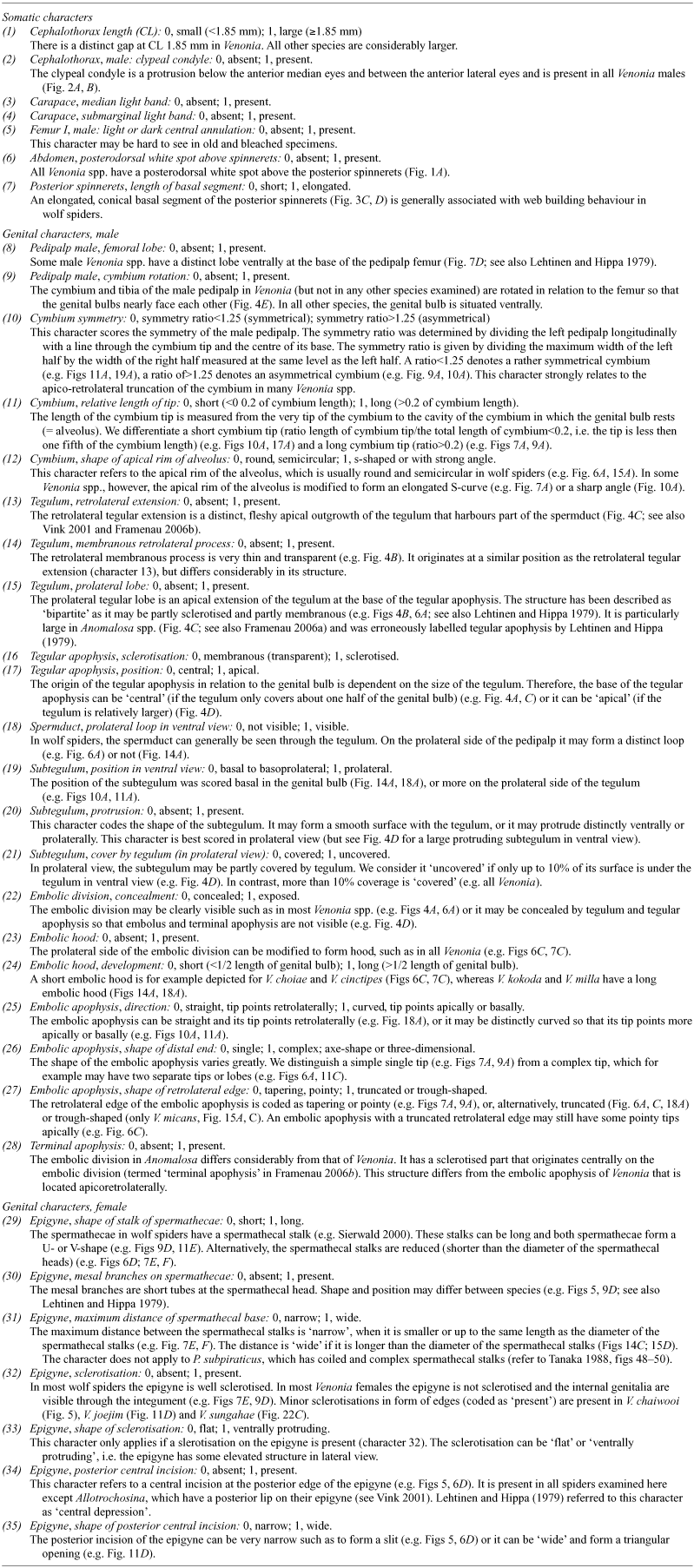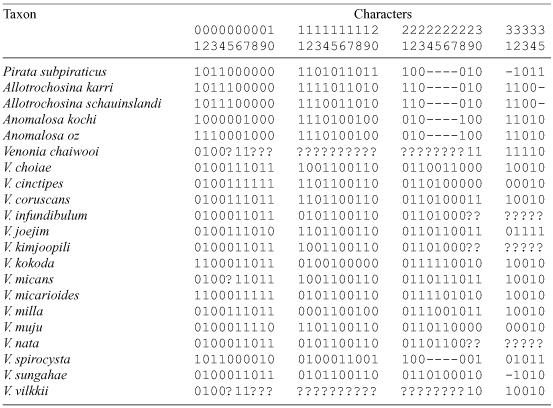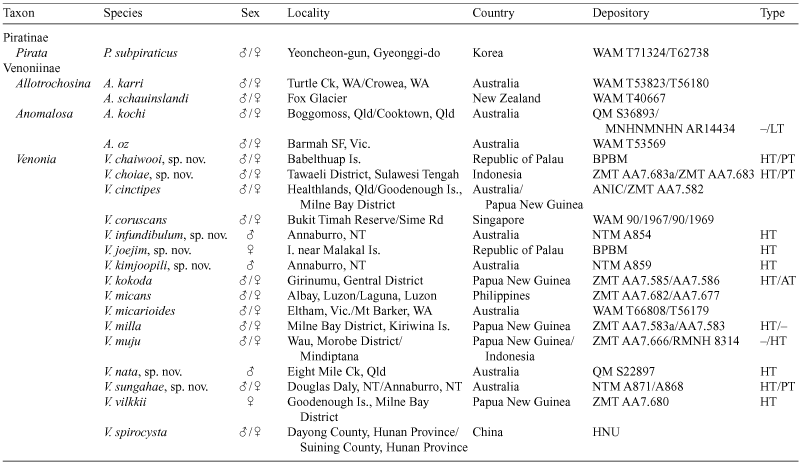Systematics and biogeography of the sheet-web building wolf spider genus Venonia (Araneae : Lycosidae)
Jung-Sun Yoo A B C D and Volker W. Framenau AA Department of Terrestrial Invertebrates, Western Australian Museum, Locked Bag 49, Welshpool DC, Western Australia 6986, Australia.
B School of Animal Biology, University of Western Australia, Crawley, Western Australia 6009, Australia.
C Research Institute for Natural Science, Dongguk University, Seoul 100-715, Korea.
D Corresponding author. Email: jung-sun.yoo@museum.wa.gov.au
Invertebrate Systematics 20(6) 675-712 https://doi.org/10.1071/IS06013
Submitted: 19 April 2006 Accepted: 21 September 2006 Published: 15 December 2006
Abstract
The Australian/Oriental wolf spider genus Venonia Thorell, 1894 (type species V. coruscans Thorell, 1894) belongs to one of the few true web-building genera within the Lycosidae. Their small sheet-webs with funnel-like retreats are generally found in the ground layer of vegetation, such as on lawns and meadows, but also in depressions of soil and under roots of trees. Members of the genus Venonia are easily identified within the Lycosidae due to a unique combination of somatic and genitalic characters. Most conspicuous is a posterodorsal white spot on the abdomen just above the elongated posterior spinnerets on an otherwise uniformly coloured, small, and relatively slender spider. The cymbium of the male pedipalp is highly asymmetrical appearing retrolaterally truncated. Its tegular apophysis is membranous. The female epigyne is generally not sclerotised and has a posterior central incision. Our revision recognises fifteen species of which seven are new to science: V. chaiwooi, sp. nov.; V. choiae, sp. nov.; V. cinctipes (Simon, 1898); V. coruscans Thorell, 1894; V. infundibulum, sp. nov.; V. joejim, sp. nov.; V. kimjoopili, sp. nov.; V. kokoda Lehtinen & Hippa, 1979; V. micans (Simon, 1898) (= Venonia gabrielae Barrion & Litsinger, 1995, new synonymy); V. micarioides (L. Koch, 1877); V. milla Lehtinen & Hippa, 1979; V. muju (Chrysanthus, 1967); V. nata, sp. nov.; V. sungahae, sp. nov.; and V. vilkkii Lehtinen & Hippa, 1979. A phylogenetic analysis including representatives of the venoniine genera Anomalosa Roewer, 1960 and Allotrochosina Roewer, 1960 with Pirata subpiraticus (Bösenberg & Strand, 1906) as outgroup suggests a Gondwanan origin of the Venoniinae and one dispersal event within Venonia from the Australian region into Wallacea and only one dispersal event by V. coruscans into the Oriental region. Venonia spirocysta Chai, 1991 from China is not a true Venonia and is here considered incerta sedis. We reject the inclusion of the genus Zoica Simon, 1898 in the subfamily Venoniinae Lethinen & Hippa, 1979 due to considerable morphological differences in representatives of this genus (in particular in the male pedipalp), and therefore consider the subfamily Zoicinae Lehtinen & Hippa, 1979 as valid.
Acknowledgments
We are grateful to the following people for the loan of specimens used in this study: Mike Gray and Graham Milledge (AM); Bruce Halliday and Sandy Roy (ANIC); Janet Beccaloni (BMNH); Yin Chang-Min (HNU); Gary Jahn and Josie Catindig (IRRI); Anne-Elise Leguin and Christine Rollard (MNHN); Peter Lillywhite, Ken Walker and Richard Marchant (MV); Nigel Monaghan (NMI); Erik Nieukerken and B. Van Bekkum-Ansari (RMNH); Gavin Dally and Tracy Churchill (NTM); Rob Raven and Owen Seeman (QM); David Hirst (SAM); Seppo Koponen (ZMT). In particular, we want to acknowledge the help of Jim Berry (Butler University, Indianapolis) and Joe Beatty (Southern Illinois University at Carbondale) who made their Pacific islands wolf spider material available for our study. Young-Bo Lee and An-Ja Ko (National Institute of Agricultural Science and Technology, RDA, Suwon, Korea) took the SEM photographs. Bill Humphreys made one of his stereomicroscopes available for the use of the senior author. We thank Sung-Ah Kim for compiling some tables and parts of this study. The senior author is particularly grateful to his father and mother for their lifelong and continuing support without which this study would not have been possible. The contribution of Joo-Pil Kim (Dongguk University, Seoul) and Yung-Chul Park (Ewha Womans University, Seoul) to the senior author’s study of Australasian wolf spiders is acknowledged. The Australian Biological Resources Study (ABRS) (Mark Harvey, WAM, and Andy Austin, The University of Adelaide) provided funding for VWF. This work was supported by the Korea Research Foundation Grant funded by the Korean Government (MOEHRD). (KRF-2005- 214-C00226) to JSY.
Bösenberg W., Strand E.
(1906) Japanische Spinnen. Abhandlungen der Senckenbergischen naturforschenden Gesellschaft 30, 93–422.
[verified 20 November 2006].
Gravely F. H.
(1924) Some Indian spiders of the family Lycosidae. Records of the Indian Museum Calcutta 26, 587–613.
[verified 12 April 2006].
McKay R. J.
(1973) The wolf spiders of Australia (Araneae: Lycosidae): 1. The bicolor group. Memoirs of the Queensland Museum 16, 375–398.
[verified 20 November 2006].
Petrunkevitch A.
(1928) Systema Aranearum. Transactions of the Connecticut Academy of Arts and Science 29, 1–270.

Rack G.
(1961) Die Entomologischen Sammlungen des Zoologischen Staatsinstituts und Zoologischen Museums Hamburg. II. Teil Chelicerata II: Araneae. Mitteilungen des Hamburgischen Zoologischen Museums und Instituts 59, 1–60.

Rainbow W. J.
(1911) A census of Australian Araneidae. Records of the Australian Museum 9, 107–319.

Roewer C. F.
(1959) Araneae Lycosiformae II (Lycosidae). Exploration du Parc National de l’Upemba – Mission GF de Witte 55, 1–518.

Sierwald P.
(2000) Description of the male of Sosippus placidus, with notes on the subfamily Sosippinae (Araneae, Lycosidae). The Journal of Arachnology 28, 133–140.
| Crossref | GoogleScholarGoogle Scholar |

Simon E.
(1885) Matériaux pour servir à la faune arachnologiques de l’Asie méridionale. I. Arachnides recuellis à Wagra-Karoor près Gundacul, district de Bellary par M. M. Chaper. II. Arachnides recuellis à Ramnad, district de Madura par M. l’abbé Fabre. Bulletin de la Société Zoologique de France 10, 1–39.

Simon E.
(1887) Observation sur divers arachnides: synonymies et descriptions. Annales de la Société Entomologique de France 7, 158–195.

Simon E.
(1898b) Descriptions d’arachnides nouveaux des familles des Agelenidae, Pisauridae, Lycosidae et Oxyopidae. Annales de la Société Entomologique de Belgique 42, 1–34.

Storey B. C.
(1995) The role of mantle plumes in continental breakup: case histories from Gondwanaland. Nature 377, 301–308.
| Crossref | GoogleScholarGoogle Scholar |

Tanaka H.
(1988) Lycosid spiders of Japan I. The genus Pirata Sundevall. Acta arachnologica. Tokyo 36, 33–77.

Thorell T.
(1894) Decas aranearum in ins. Singapore a Cel. Th. Workman inventarum. Bolletino della Società Entomologica Italiana 26, 321–355.

Vink C. J.
(2001) A revision of the genus Allotrochosina Roewer (Lycosidae: Araneae). Invertebrate Taxonomy 15, 461–466.
| Crossref | GoogleScholarGoogle Scholar |

Vink C. J., Paterson A. M.
(2003) Combined molecular and morphological phylogenetic analyses of the New Zealand wolf spider genus Anoteropsis (Araneae: Lycosidae). Molecular Phylogenetics and Evolution 28, 576–587.
| Crossref | GoogleScholarGoogle Scholar | PubMed |

Zyuzin A. A.
(1993) Studies on the wolf spiders (Araneae: Lycosidae). I. A new genus and species from Kazakhstan, with comments on the Lycosinae. Memoirs of the Queensland Museum 33, 693–700.


|

|



